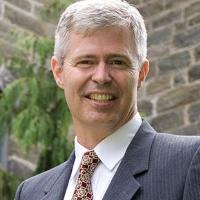Commentary on Luke 17:11-19
Amid the various ecclesial, ethical, and liturgical reforms of the sixteenth century, Martin Luther was once asked to describe the nature of true worship.
His answer: the tenth leper turning back. Paying attention to a few details will help us appreciate Luther’s insight into Luke’s unique story.
Details, Details
First: given that Samaria and Galilee border each other, there is no “region between” them, and even if there were, it would be an odd route to take toward Jerusalem. It may be that Luke has little grasp of the topography he describes, but I tend to think his point is theological rather than geographical. Jesus is on his way to Jerusalem, to the cross, and the encounters he has along the way reveal something about the nature of the kingdom he will establish there. This encounter happens in a middle space, where one would expect the tension between ethnic and religious differences to be palpable. What God inaugurates through Jesus is made manifest in this “region between.”
Second: much that happens in this brief scene is fairly typical. Neither the pattern of healing — a plea followed by an eminently observable command — nor the response of worship from the one who returns — to praise, prostrate, and thank — is unique. Both are reliable elements in healing stories. God acts in and through the ordinary.
Third: against this backdrop, two details stand out. 1) Given that Jesus has commanded the ten to follow the law, his question seems a tad disingenuous: “Where are the other nine?” To which one might answer, “They are going to show themselves to the priests in accordance with the law…just like you told them to do.” Then why does Jesus ask? 2) The one who returns is a Samaritan or, as Jesus describes him, a foreigner; that is, one a first-century Jew would not normally look to as an example. Amid the ordinary, something has changed.
Fourth: Jesus says to the Samaritan, “Your faith has made you well” (NRSV, NIV). One might also translate it, as Eugene Peterson does, “your faith has healed and saved you” (The Message). The Greek work, sesoken, from the root sozo, can be translated any of these ways: healed, made well, saved. It can also be translated, with the King James Version, “Your faith has made you whole.” However we translate it, one thing is clear: there is more at stake here than mere healing.
Seeing and Believing
Taken together, these details orient us to the possibility that Jesus instructs his followers — then and now — that faith is not a matter of believing only, but also of seeing. All the lepers were healed; one, however, saw, noticed, let what happened sink in…and it made all the difference.
*Because he sees what has happened, the leper recognizes Jesus, his reign and his power.
*Because he sees what has happened, the leper has something for which to be thankful, praising God with a loud voice.
*Because he sees what has happened, the leper changes direction, veering from his course toward a priest to first return to Jesus.
In this light, this story serves as an invitation to believers — then and now — to recognize that what we see makes all the difference. In the face of adversity, do we see danger or opportunity? In the face of human need, do we see demand or gift? In the face of the stranger, do we see potential enemy or friend?
And it goes further. When we look to God, do we see stern judge or loving parent? When we look to ourselves, do we see failure or beloved child? When we look to the future, do we see fearful uncertainty or an open horizon? There is, of course, no right answer to any of these questions. How we answer depends upon what we see. Yet how we answer dramatically shapes both our outlook and our behavior.
Perhaps this is the key to the stewardship campaigns that so many pastors will be overseeing throughout this month. Stewardship is not first about giving, but about seeing all that we have been given and rejoicing in a way that cannot help but shape how we act.
Perhaps this is also the key to the worship we carefully plan and tend week in and week out. Worship is not simply about hearing God’s story or even praising God in response; rather, hearing the story through Scripture and sermon and praising through song and gifts is all intended to help us see God at work in our lives and the world. Perhaps this is even the key to the Christian life. Before we are called to believe or confess or help or do we are called simply to see…and to help others do the same. We are called, that is, to point out blessing, to claim mercy, to name grace wherever we are and with all the courage we can muster.
At the outset of this story, ten men are stuck. They live “between regions” in a “no-man’s” land of being socially, religiously, and physically unclean. By the end of the story, all ten are made well. But one has something more. He has seen Jesus, recognized his blessing and rejoiced in it, and changed his course of action and behavior. And because he sees what has happened, the leper is not just healed, but is made whole, restored, drawn back into relationship with God and humanity. In all these ways he has been, if we must choose a single word, saved.
What is true stewardship, worship, and Christian living? It is the tenth leper turning back. For now as then, seeing makes all the difference.

October 10, 2010